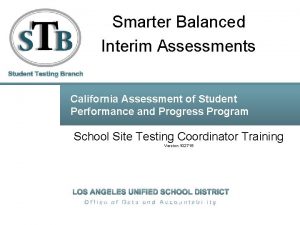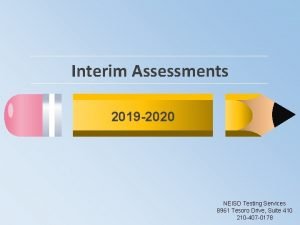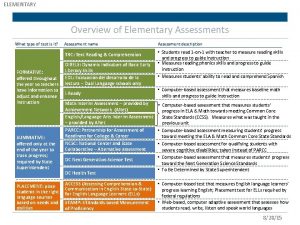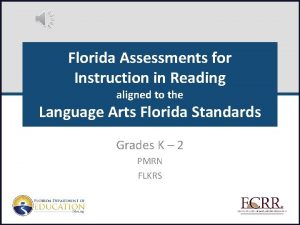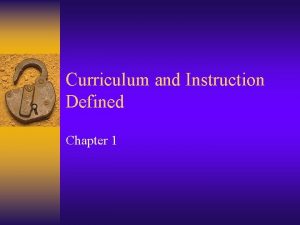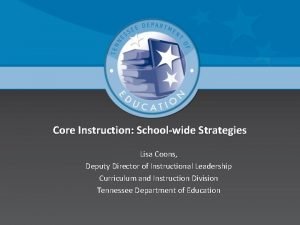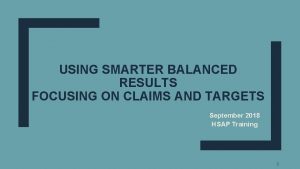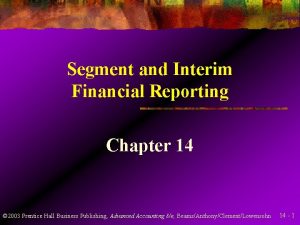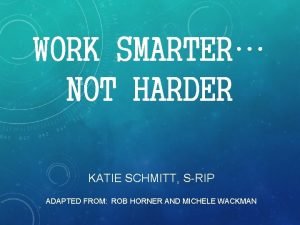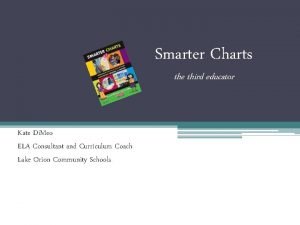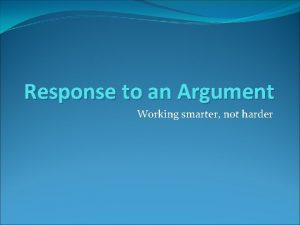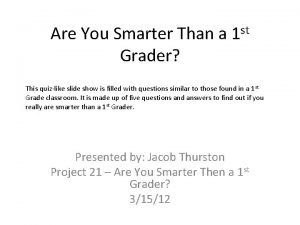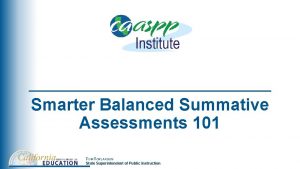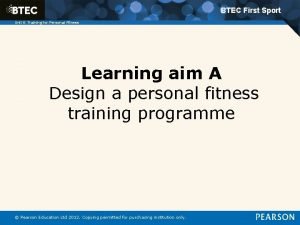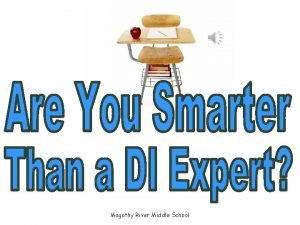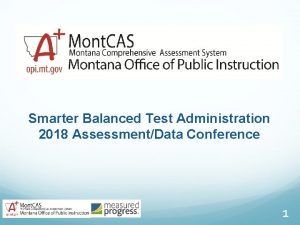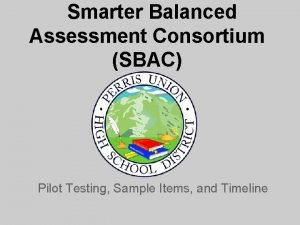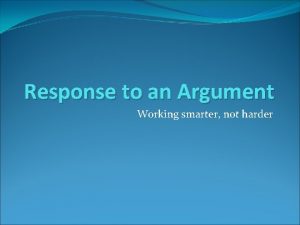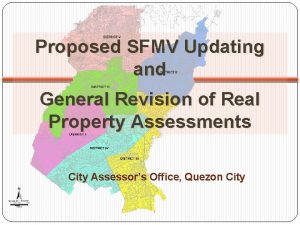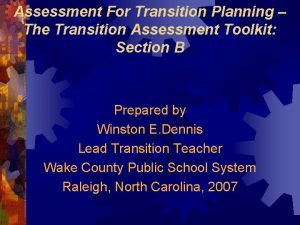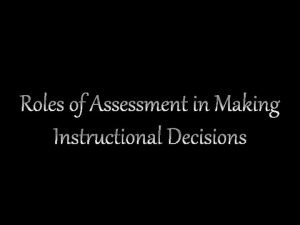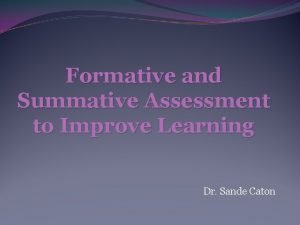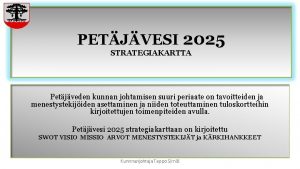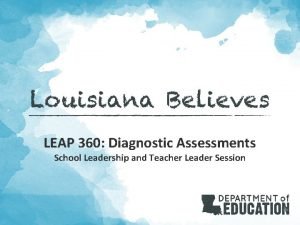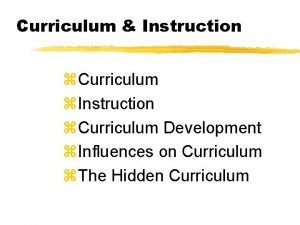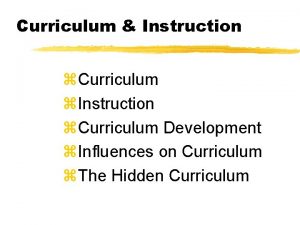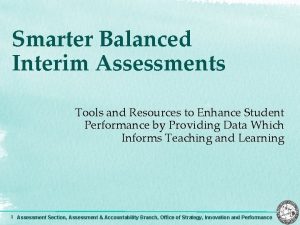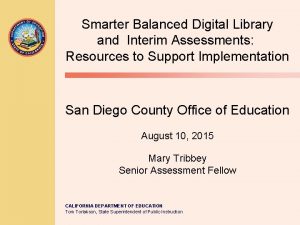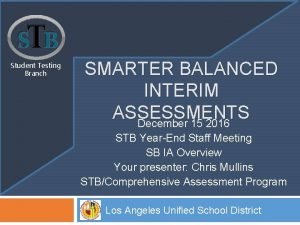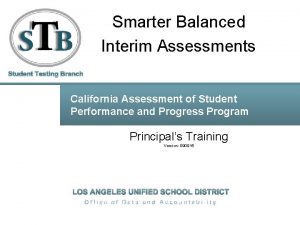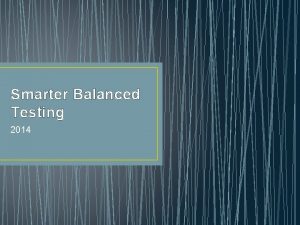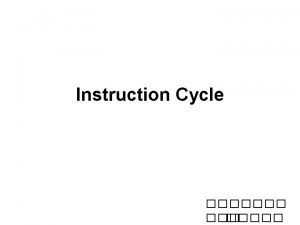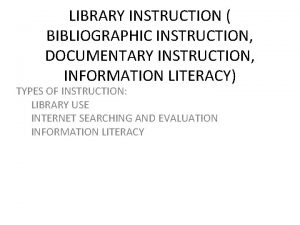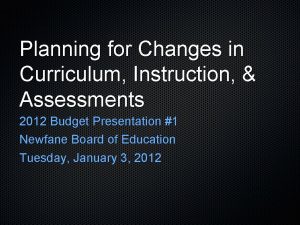Smarter Interim Assessments Overview and HandScoring Curriculum Instruction













































- Slides: 45

Smarter Interim Assessments Overview and Hand-Scoring Curriculum, Instruction, & Professional Development (CIPD) and Office of Assessment

Agenda • Interim Assessment Overview • Hand Scoring for Interim Assessments • Teacher Hand Scoring System (THSS) 2

A Balanced Assessment System 3

Interim Assessments • Designed to support teaching and learning throughout the year – Feedback to inform instruction including • Global measures of early and midyear progress • Identify specific areas of strength and weakness • Assess skills of incoming students 4

Interim Assessment • Same as summative – all items were developed together – assess Common Core State Standards – use Universal Design principles – same accessibility resources – provide evidence to support claims in mathematics and English language arts/literacy • Different from summative – Not secure, but not public • Summative and Interim are assessed online 5

Two Types of Interims • Interim Comprehensive Assessments (ICAs) – Same design as summative tests – Assess same claims and standards – Yield overall scale scores, performance level designation and claim score information • Interim Assessment Blocks (IABs) – Assess smaller sets of targets – Address specific content areas – More flexible – Reported as “Below Standard, “At/Near Standard, ” and “Above Standard” 6

Two Types of Interims Interim Comprehensive Assessments (ICAs) Use the same blueprints as the summative assessments and assess the same standards. Available as fixed form tests and may also be available as adaptive tests when item counts are adequate. Include the same item types and formats, including performance tasks, as the summative assessments Yield overall scale scores (on the same vertical scale), overall performance level designations, and claim-level information. Claim-level information results reported in the Smarter Balanced reporting system as “Below Standard, ” “At/Near Standard, ” and “Above Interim Assessment Blocks (IABs) Focus on smaller sets of targets and therefore are more flexible to better support instruction Available as fixed form tests and may also be available as adaptive tests, as appropriate based on content and when item counts are adequate. Include the same item types and formats, including performance tasks, as the summative assessments. Yield overall information for each block. Results will be reported as “Below Standard, “At/Near Standard, ” and “Above Standard”. 7

Administration Characteristics • Scoring of non-machine scored items is a local responsibility – ICAs and some IABs have items that are not machine-scored – Teacher Hand Scoring System (THSS) provided through De. SSA • Scoring of tests – Same scoring rules as summative tests 8

Administration Characteristics • Grade flexibility – Available for students in grades 3 through 8 – Tests from any grade can be used, depending on purpose • Both ICAs and IABs can be administered multiple times during the year – Tests draw from the same interim pool – Students may see some of the same items more than once – Decisions about test choice and frequency are determined by district or school plans for test purpose and score use 9

Examples of Usage Example Use Cases Interim Comprehensive Assessments Interim Assessment Blocks (IABs) (ICAs) Beginning of the year: Students enter a A teacher recently changed his 4 th grade class after summer break. The instruction to emphasize reading teacher gives the students an interim informational text. The teacher rd assessment aligned to the 3 grade administers a Read Informational content standards to better understand Texts IAB to augment his formative what knowledge and skills students information regarding the degree to retained over the break. which students learned the skills he emphasized. Midyear: A 6 th grade teacher has collected formative information that An 8 th grade mathematics team has indicate her students have learned a reviewed the last 3 years worth of 8 th substantial portion of the 6 th grade summative data and wants to content standards. The teacher determine whether or not students’ administers an interim assessment to understanding of Geometry is an provide additional data about the important factor in their overall students’ progress. performance in mathematics. The team administers the 8 th grade Geometry IAB to their current 8 th grade students and reviews the results as part of a professional learning community. 10

ICAs and IABs • Non-overlapping item banks • Increased size of interim item pool – allows for frequent use of interim assessments without students seeing the same items more than once • Continued research on automatic scoring of constructedresponse items 11

IABs for 2016 -2017 - ELA Grades 3 -8 Delaware Department of Education 12

Hand Scoring for Interim Assessments Curriculum, Instruction, & Professional Development (CIPD) and Office of Assessment

SBAC ELA Hand Scoring Item Types • Short Text – Brief Write • Constructed Responses • Essay – Full Write

Full Write Rubric for Full Writes – Narrative – Grades 3 -8 – Organization/Purpose

ELA – Research Rubric

ELA Reading Rubric

ELA Brief Write

Place Holder for Item Specific Rubric • Use this slide for your constructed response or short text – Choose your item type to score – Visit TIDE to access materials • The items used in the DOE Hand Scoring are secure and cannot be shared in the power point.

TIDE Access • Use a supported browser http: //de. portal. airast. org/supportedbrowsers/ • Access the DDOE IMS login page at https: //login. doe. k 12. de. us. Use your regular IMS ID and password to log in • Click the [De. SSA/DCAS] button. You will be directed to the De. SSA Portal • Click the [Smarter Balanced ELA & Mathematics] user card. You will be directed to the selected “Welcome” page, which includes links to the available De. SSA applications • Choose the TIDE application • Navigate to the Resources Link 20

TIDE Resources

TIDE Materials found in TIDE include • Brief writes • Full writes • Performance Tasks • Prep Sets with anchors and annotations • Training Guides with text and/or stimulus 22

Understanding the Codes Examples: • ELA—G 3 C 1 PS Hook means Grade 3, Claim 1, Prep Set, Topic C 1 – Claim 1: Reading Items C 2 – Claim 2: Brief Writes C 4 – Claim 4: Research Items PS – Prep Set: contains the anchors with the annotations TG – Training Guide: includes the text and/or stimulus [Name] – Topic of the text/resources

Hand Scoring Protocol Hand Scoring • Read the sources and accompanying item stem, target specific rubric, condition code document, and target chart – [Note your rubric type here. ] • • Examine the target specific rubric and rationale for each score point. Read through the condition code document to better understand how to score unusual responses Read the document containing the prep set, check set, scoring key Score the Exemplar/Sample Table consensus for Exemplar/Sample Debrief Whole Group Score anchor packet (student work) – Score [Note: Add if there is a particular trait that is to be scored. ] – Come to a table consensus [Note: Table facilitators use charts. ] • • Compare Baseline Anchor Responses to Group Consensus Scores [Note: Compare participants scores to annotated scores. ] Table Facilitators list papers still in question on the whole group chart - Whole Group Debrief on papers in question 24

Transition to the SBAC Scoring Guide • Hand scoring practice with the SBAC Scoring Guide • Grade 3 Narrative Full Write • Scored for Organization/Purpose, Development/Elaboration, Conventions 25

SBAC Writing Rubrics Grade Levels/Types: Rubrics Include: Narrative: Grades 3 -8 3 Traits: Organization/Purpose = 4 points possible Development/Elaboration/Evidence = 4 points possible Conventions = 2 points possible Informational: Grades 3 -5 Explanatory: Grades 6 -11 NS=Not Scoreable (Insufficientincludes copied text; in a language other than English; off-topic; offpurpose) Opinion: Grades 3 -5 Argumentative: Grades 6 -11 Overarching score point descriptions with supporting bullets Asterisk* = information that is specific to a grade level; OR a note about the scoring – Examples: • Grades 6 -11 Explanatory: Conventions are scored holistically • Grades 3 -8 Narrative: Point of th

Grades 3 or 6 Narrative Performance Task Full Write (Essay) Score Organization/Purpo Development/Elaboratio se n 4 The organization of the narrative, real or imagined, is fully sustained and the focus is clear and maintained throughout: The narrative, real or imagined, provides thorough, effective elaboration using relevant details, dialogue, and/or description: 2 NS Conventions The response demonstrates and adequate command of conventions: • • Insufficient (includes copied text) In a language other than English Off-topic Off-purpose

SBAC Scoring Guide Note Taker Sco Organizatio re n/ Poi Purpose nts 4 3 2 1 Development/ Elaboration Conventi ons 1. Individually - Note the trends in the annotations for each trait at each score point. 2. Table discussion – whole group debrief.

Grades 3 or 6 Narrative Performance Task Full Write (Essay) Hand Scoring 1. Read/review the item-specific rubric – Narrative – Organization/Purpose – Use Note-Taker during review and scoring 2. Score Baseline Anchor Response #11 3. Compare Response #11 with Sample A Baseline Anchor 4. Score student work – Score and reasoning – Come to a table consensus 5. Compare Anchor Responses to Group Consensus Scores 6. Table Facilitators list papers still in question - Whole Group Debrief 29

Smarter Balanced Scoring Guide (p. 2) • Grades 3, 6, & 11 • English/Language Arts Performance Task Full-Write Baseline Sets – Writing Tasks • • Problem/question/circumstance Relevant source material and a writing task Writing topic, audience, purpose, form, and writing criteria Each student will respond to one performance task

Smarter Balanced Scoring Guide (p. 2) • English/Language Arts Performance Task – Source Materials • • Grade appropriate 2 -5 texts depending on grade Informational/explanatory and opinion/argumentative are text based Narrative may be more text-inspired; i. e. , connections to source materials may contribute to or enhance the narrative • Students will use source materials to support ideas

Smarter Balanced Scoring Guide (p. 2) • English/Language Arts Performance Task – Writing Purposes • Narrative • Informational/Explanatory • Opinion/Argumentative – Each writing purpose has a different purpose-specific scoring rubric • Grades 3 -8 narrative purpose – using information in the sources to write a story or capture the essence of an experience; Grade 11 will not receive narrative purpose • Grades 3 -5 informational purpose using source material to inform an audience about a topic; Grades 6 -11 explanatory purpose, analyzing source material to explain some aspect of a subject • Students in Grades 3 -5 form and defend an opinion supported by information in the source material; Grades 6 -11 compose an argument using evidence from the source material to form and support claims and in Grades 7 -11, counterclaims

Smarter Balanced Scoring Guide (p. 2) • English/Language Arts Performance Task – Writing Forms • Clear expected writing form or product • Grade appropriate; i. e. , letter or report for earlier grades – more sophisticated essays in later grades – Audience • Appropriate for grade level, purpose, and situation for the task • Familiar audiences for younger students; i. e. , parents, principal • General audiences for older students; i. e. , legislative bodies, Internet audiences

Smarter Balanced Scoring Guide (p. 3) • Baseline Anchor Set – Professional contractor scorers trained to use SBAC scoring rubrics – Preliminarily score a range of student responses identifying top level responses and then identifying samples representing different score points – Educators form SBAC states review, agree and/or validate sample responses that define the range of each score point

Smarter Balanced Scoring Guide (p. 3) – In order to maintain the security of the spring 2014 Field Test items for use in the 2015 Summative and Interim item banks, the student responses included in this guide were selected from the SBAC 2013 Pilot Test. – The writing sample can help illustrate the descriptors for each score-point category on the SBA writing rubrics; therefore, we see the baseline anchors as a useful educator tool. – The first Baseline Anchor Sets are, however, just the beginning of what will become full and rich sets of student writing, that include a wide variety of purposes and writing forms for each grade.

Using the SBAC Scoring Guide as a Resource Hand Scoring: • Score and annotate SBAC Scoring Guide anchors for organization and conventions; then compare teacher scores and annotations to the Baseline samples • Score and annotate grade level student writing; then, compare teacher scores and annotations to the Baseline samples Implications of Writing Instruction and Assessment: • Use SBAC Scoring Guide with the SBAC Note Taker; discuss expectations at each score point and trait • Use SBAC Scoring Guide with the SBAC Note Taker; discuss implications for teaching writing and deeper understanding of the CCSS writing standards

Teacher Hand Scoring System (THSS) • Teacher Hand Scoring System (THSS) allows teachers (scorers) to assign scores to student responses • When students in a test session submit an assessment, the open-ended items are sent to THSS, where teachers can view students’ responses to each item and enter the appropriate score 37

De. SSA Assessment Viewing Application (AVA) Office of Assessment August 2015

Assessment Viewing Application (AVA) Overview • System used for Interim Assessments only • Educators and students can see the interim test without using specific student login information • AVA system is accessible through IMS on the De. SSA Portal using Firefox Browser • The features of AVA are the same as the Interim tests (tools, pause rule, flagging an item for review, completing the review) http: //de. portal. airast. org/wp-content/uploads/2015/08/AVA_User. Guide_2015 -2016 -082015. pdf 39

Interim Assessments - Grade 3 Office of Assessment Helen Dennis – helen. dennis@doe. k 12. de. us Katia Foret – katia. foret@doe. k 12. de. us 40

Training for De. SSA http: //de. portal. airast. org/resources/? section=6 Must complete the training in order to access the AVA. 41

Teacher Hand Scoring System (THSS) 42

Teacher Hand Scoring System (THSS) 43

Teacher Hand Scoring System (THSS) 44

Interim Comprehensive Assessment Scoring Student Responses • Student responses are scored using the Teacher Hand Scoring System available on the De. SSA portal. • Supplemental trainings are provided to assist with this process and score entry. • For a full list of trainings visit the De. SSA portal – Smarter ELA/Math Resources – Trainings and Certifications 45
 Lausd interim assessments
Lausd interim assessments Staar interim assessments 2019-2020
Staar interim assessments 2019-2020 Anet interim assessments
Anet interim assessments Florida assessment for instruction in reading
Florida assessment for instruction in reading Interlocking model of curriculum
Interlocking model of curriculum Curriculum and instruction
Curriculum and instruction Vocabulary strategies
Vocabulary strategies Differentiated instruction vs individualized instruction
Differentiated instruction vs individualized instruction Difference between direct and indirect instruction
Difference between direct and indirect instruction Computers make the world smaller and smarter answers
Computers make the world smaller and smarter answers Computers make the world smaller and smarter
Computers make the world smaller and smarter Alohahsap
Alohahsap Segment and interim reporting chapter 8
Segment and interim reporting chapter 8 Meaning of auditing
Meaning of auditing Working smarter matrix
Working smarter matrix Smarter vision
Smarter vision Smarter charts
Smarter charts Smarter 2030
Smarter 2030 Work smarter, not harder essay
Work smarter, not harder essay Ibm smarter planet strategy
Ibm smarter planet strategy Are you smarter than a food label
Are you smarter than a food label Are you smarter than sam questions
Are you smarter than sam questions Ibm supply chain risk management
Ibm supply chain risk management Official smarter balanced summative assessment
Official smarter balanced summative assessment Making smart contracts smarter
Making smart contracts smarter Ulrich pluta
Ulrich pluta Smarter btec sport
Smarter btec sport Magothy river middle school
Magothy river middle school Are you smarter than a 5th grader lyrics
Are you smarter than a 5th grader lyrics Montana sbac secure browser
Montana sbac secure browser Smarter balanced.org
Smarter balanced.org Smarter balanced sample items
Smarter balanced sample items Work smarter not harder passage
Work smarter not harder passage Smarter inventories
Smarter inventories General revision of assessments and property classification
General revision of assessments and property classification Formal vs informal assessment
Formal vs informal assessment Formal and informal test
Formal and informal test Placement formative diagnostic and summative assessment
Placement formative diagnostic and summative assessment Physical fitness grade 9
Physical fitness grade 9 التحصيلي
التحصيلي Munitions history program answers
Munitions history program answers Kadar dividen syer biasa
Kadar dividen syer biasa Interim-projektijohtaja
Interim-projektijohtaja Leap 360 geometry interim test form 1 answer key
Leap 360 geometry interim test form 1 answer key Leap 360 scoring guide
Leap 360 scoring guide Interim removable partial dentures
Interim removable partial dentures
